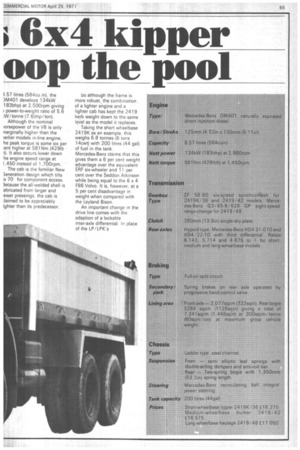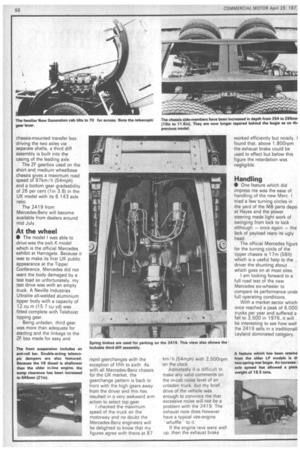ONE of the stars at the RHA Tipper Conference exhibition
Page 66

Page 67

Page 68

If you've noticed an error in this article please click here to report it so we can fix it.
is the new 6 x 4 truck from Mercedes-Benz. Titled the 2419, it replaces the existing LP2419 model from which it is easily distinguished by the New Generation Cab.
Three wheelbase versions are available with the shortest at 3.6m (lift 10in) being given the suffix ''K" (Kipper is the German for tipper) to indicate that it is intended primarily for tipper application. The choice of wheelbase also determines the transmission specification.
The 3.6 and 4.2m (lift 10in and 13ft 9in) wheelbase models are listed with ZF six-speed synchromesh gearboxes while the longer 4.8m (15ft 10in) model — intended for haulage operation — comes equipped with the eight-speed range-change Mercedes gearbox, already in use on the 1617 16-tonner.
Compared with the old LP and LPK2419 models, the new six-wheeler shares several features although there are also several major differences.
The chassis frame is deeper and the side-members are continued through at full depth instead of being tapered behind the bogie as on the previous model.
Compared with the 254mm (10in) frame depth of the LP, the dimension has been increased to 295mm (ii Gin) on the new truck. Mercedes-Benz claims that this has allowed a reduction in the size of the cross-members while imparting greater bending strength so that a reinforcing sub-frame is not required.
To keep the weight down to approximately the same level as the LP, the steel specification has been upgraded for the tipper model so it is 28 per cent stronger than that used for the longer variants.
Another major change has been the move to full-air braking. This is a split system which utilizes spring brakes for parking. The move to full air has simplified the provision of trailer brake connections so that the 2419 can be engineered to special order for drawbar operation at up to 30 tons gtw.
One feature which has been retained from the old square cab model is the two-spring rear-bogie design although even this has been changed slightly in that the axle spread has been increased from 1,315 to 1,350mm (51.8 to 53.1in) to allow a rear axle load of 18.8 tonnes (18.5 tons) on the public road giving more loading tolerance.
More loading flexibility can be achieved by altering the tyre specification. By specifying the optional 12 x 22.5 tyres in place of the standard 11 x 22.5 on the front axle, the operator can raise the plated weight from 6.1 to 6.6 tonnes (6 to 6.5 tons).
New to Britain
• The 2419 is the first Mercedes fitted with the 0M401 V6 engine to be offered on the UK market It is part of the same modular range as the V8 and V10 units already well known in the 1626 and 1632 tractive units and as such shares the same bore and stroke. In fact it shares so many common components that Mercedes claims that 80 per cent are common with the 1 626 V8 engine With a cubic capacity of 3.57 litres (584cu.in), the )M401 develops 134kW 183bhp) at 2,500rpm giving power-to-weight ratio of 5.6 :W/tonne (7.6bhp/ton).
Although the nominal lorsepower of the V6 is only narginally higher than the arlier models in-line engine, he peak torque is some six per :ent higher at 581Nm (429Ib t). It also occurs lower down he engine speed range at 1,450 instead of 1,700rpm.
The cab is the familiar New .3eneration design which tilts o 70 for component access. 3ecause the all-welded shell is abricated from larger and ewer pressings, the cab is laimed to be appreciably ighter than its predecessor.
So although the frame is more robust, the combination . of a lighter engine and a lighter cab has kept the 2419 kerb weight down to the same level as the model it replaces.
Taking the short wheelbase 2419K as an example this weighs 6.8 tonnes (6 tons 14cwt) with 200 litres (44 gal) of fuel in the tank. Mercedes-Benz claims that this gives them a 6 per cent weight advantage over the equivalent ERF six-wheeler and 11 per cent over the Seddon Atkinson while being equal to the 6 x 4 F86 Volvo. It is, however, at a 5 per cent disadvantage in weight when compared with the Leyland Bison.
An important change in the drive line comes with the adaption of a lockable inter-axle differential. In place of the LP/LPK's chassis-mounted transfer box driving the two axles via separate shafts, a third diff assembly is built into the casing of the leading axle.
The ZF gearbox used on the short and medium wheelbase chassis gives a maximum road speed of 97km/h (54mph) and a bottom gear gradeability of 26 per cent (1 in 3.8) in the UK model with its 6.143 axle ratio.
The 2419 from Mercedes-Benz will become available from dealers around mid July.
At the wheel
• The model I was able to drive was the swb K model which is the official Mercedes exhibit at Harrogate. Because it was to make its first UK public appearance at the Tipper Conference, Mercedes did not want the body damaged by a test load so unfortunately, my test drive was with an empty truck. A Neville Industries Ultralite all-welded aluminium tipper body with a capacity of 12 cu.m (15.7 cu yd) was fitted complete with Telehoist tipping gear.
Being unladen, third gear was more than adequate for starting and the linkage to the ZF box made for easy and rapid gearchanges with the exception of fifth to sixth. As with all Mercedes-Benz chassis for the UK market, the gearchange pattern is back to front with the high gears away from the driver and this has resulted in a. very awkward arm action to select top gear I checked the maximum speed of the truck on the motorway and no doubt the Mercedes-Benz engineers will be delighted to know that my figures agree with theirs at 87 km/h (54mph) with 2,500rpm on the clock.
Admittedly it is difficult to make any valid comments on the in-cab noise level of an unladen truck, but my brief drive of the vehicle was enough to convince me that excessive noise will not be a problem with the 2419. The exhaust note does however have a typical vee-engine ,"whuffleto it.
If the engine revs were well up, then the exhaust brake worked efficiently but noisily. I found that, above 1,800rpm the exhaust brake could be used to effect but below this figure the retardation was negligible.
Handling
II One feature which did impress me was the ease of handling of the new Merc. I tried a few turning circles in the yard of the MB parts depo. at Hayes and the power steering made light work of swinging from lock to lock although — once again -the lack of payload rears its ugly head.
The official Mercedes figure for the turning circle of the tipper chassis is 17m (56ft) • which is a useful help to the driver the shunting about which goes on at most sites.
I am looking forward to a full road test of the new Mercedes six-wheeler to compare its performance unde full operating conditions.
With a market sector which once reached a peak of 6,000 trucks per year and suffered a fall to 3,500 in 1976, it will be interesting to see how well the 2419 sells in a traditionall Leyland dominated category.




















































































































































































